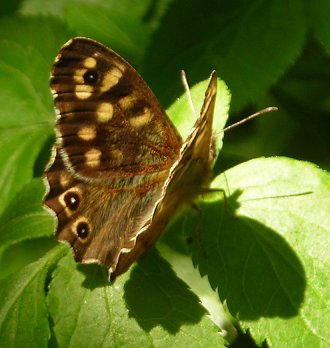
Speckled Wood butterfly
Pararge aegeria
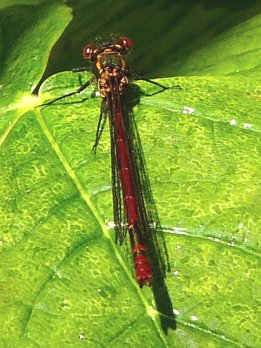
Large red damselfly Pyrrhosoma nymphula
Pyrrhosoma nymphula
Back to the Home page

This was a most enjoyable and successful Ryenats trip, on a lovely sunny day. 20 people came, including two very welcome guests from Teesdale – it is always a pleasure to welcome fellow naturalists from other clubs and societies and share their enthusiasm and expertise (which is often different from ours, so everyone learns something new).
We met at the National Trust car park where Nick Fraser greeted us, sorted out the parking and then gave us an introductory talk before leading us through the visitor centre, into the woods and to the temples. The site is mostly old woodland modified by ornamental plantings in the 18th and 19th centuries when the aim was to create multiple layers of shrubs, undershrubs and interesting foliage plants as well as colourful flowers. There is a fine mixture of mature trees, mainly oak but with beech, ash and lime as well, and many shrubs including a good deal of mountain currant which does occur sparingly as a native plant (or at least one planted by the birds!) in our woodlands. There is also quite a bit of dead wood which is left for the invertebrates; a practice that is so successful that this is an SSSI. Some of the dead wood also supports fantastic fungi, such as these large Dryad’s saddles Polyporus squamosus. There were a few freshly emerged speckled wood butterflies basking in the patches of sunshine filtering through the trees, and the eagle-eyed also spotted some red damselflies – Nan even managed to get a photo of one....


Speckled Wood butterfly |

Large red damselfly Pyrrhosoma nymphula |
Probably the botanical highlight was a patch of baneberry (also known as Herb Christopher) Actaea spicata in full flower (see photo top left; click on the picture for a larger version). Despite appearances this curious plant is a member of the buttercup family, and those feathery white flowers produce small black berries later in the summer; it is very poisonous. This is a plant with a very restricted, and odd, distribution in the UK: essentially it only grows in Yorkshire, Lancashire and Cumberland/Westmorland as it is restricted to a narrow north-south band but also only grows on limestone (so it will be in trouble if climate change gathers pace, because it won’t be able to move north easily since it would run off the limestone – just imagine what would happen here as the acid moors occur immediately to the north and this plant doesn’t have seeds that travel far).
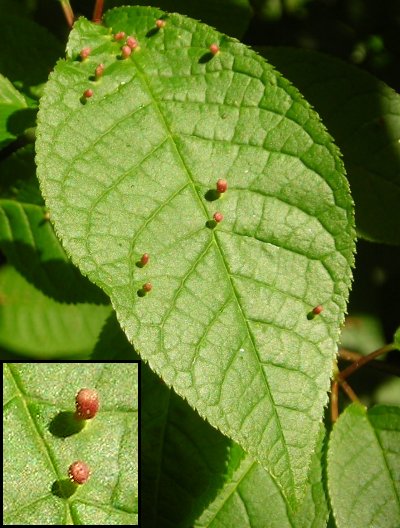
First of all we walked along the top of the wood, and then emerged at the temple, set at one end of a wide, grassy terrace. Some members of the party returned to the visitor centre along the grass, while the more intrepid of us were allowed access onto the steep slope that is not open to the public, through old woodland that has vistas cut through it to give fantastic views of the ruins of Rievaulx Abbey (see photo below).
There was a good deal of bird cherry, and we noticed that most of the leaves had little red galls on the upperside (Eriophyes padi), caused by a gall wasp. These were similar to those commonly seen on limes. The wasp lays its egg in the emerging leaf, and programmes the plant – probably using chemical instructions that hi-jack the plant’s normal development path – to produce these protective chambers for the developing grubs, one per gall. Thanks to Stuart Dunlop for the id.
View of the abbey ruins through the trees with early purple orchids and cowslips
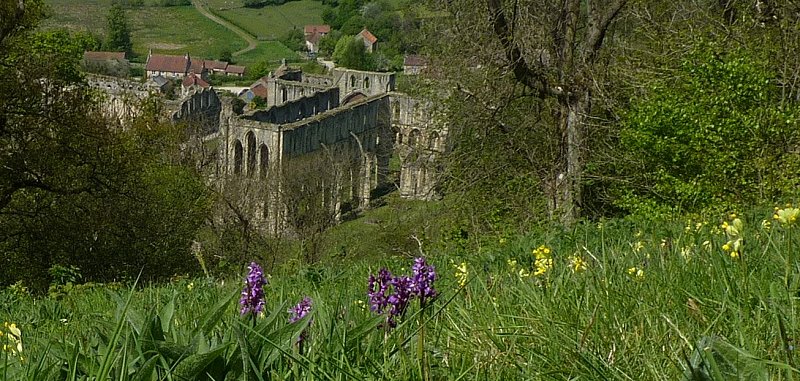 This stretch had typical old-woodland flora including bluebells, wild garlic and various ferns, and two small patches of wild columbines which, unfortunately for us, were clearly very palatable to the local deer, who had bitten off most of the flowering stems. We then climbed back up through the trees and emerged at the far end of the grass, by the other temple.
This stretch had typical old-woodland flora including bluebells, wild garlic and various ferns, and two small patches of wild columbines which, unfortunately for us, were clearly very palatable to the local deer, who had bitten off most of the flowering stems. We then climbed back up through the trees and emerged at the far end of the grass, by the other temple.
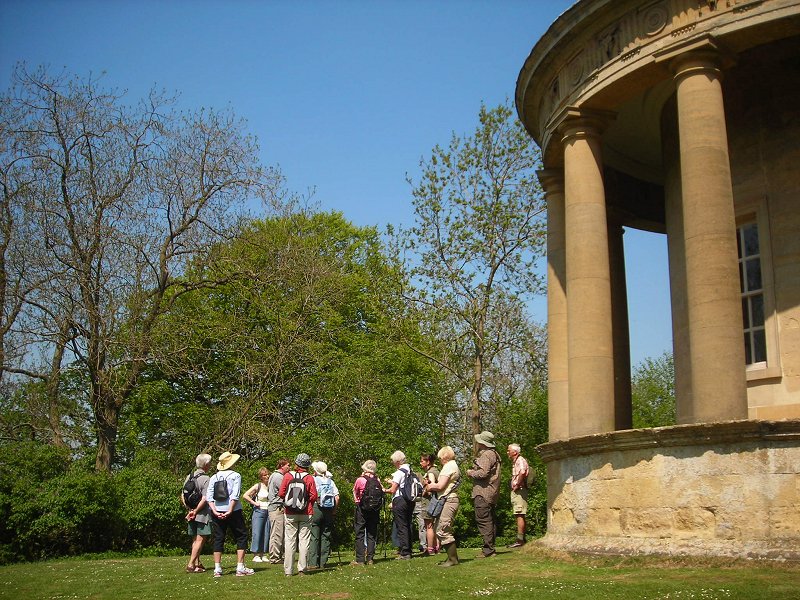
Nick kindly invited us into his garden to eat our lunch – and then things got even better: Rita offered us home-made biscuits and elderflower cordial, which was delicious and very welcome on a hot day. Many thanks to both of them!
After lunch we went on to Ashberry (sharing cars as the parking is limited nearby) where Nan was our guide. Starting at the farm we walked up the road to the bottom gate of the reserve, and then spent the afternoon happily plant-hunting, being careful where we put our feet as there are so many special things here. I think there was less interest for the birders, especially in mid-afternoon when they were quiet: but it was a nice afternoon for a siesta in the sun on the grassy bank above the beck!
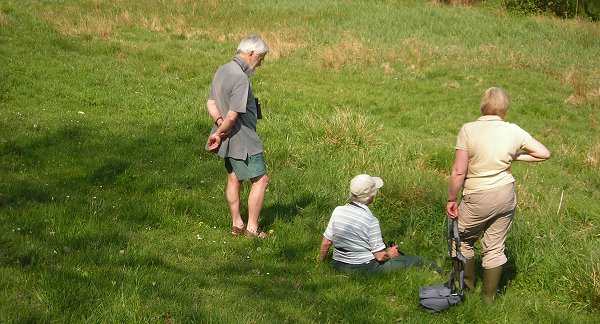
I have never known the reserve so dry, but even so we did manage to find a few early marsh orchids, and the birdseye primroses were fully out – not so the globeflower which was only in bud. Janet spotted a sport milkmaid with double flowers which would have graced any garden – in fact this is how many of our cottage garden plants were created, by an observant gardener who then propagated the unusual specimens.
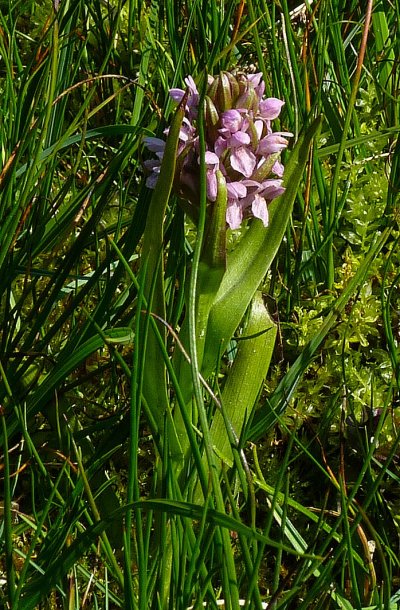 |

|
We thanked Nan, who had to leave at this point.
As a final treat a small group went to the SW corner of the reserve to see the meadow saxifrage, which was at its best, and I was delighted to see it more prolific than any previous year. We also had the chance to compare the two golden saxifrage species which grow together there near the plank bridge. It is not easy to identify these plants from the books, but seeing them side by side shows they do in fact have quite different “jizzes”. even now, when they are past their best. And I couldn’t resist a picture of this kingcup growing right on the edge of the footbridge!
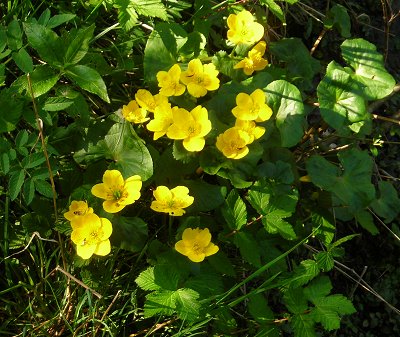
Kingcup Caltha palustris and meadow saxifrage Saxifraga granulata (right) |
 |
We then returned to pick up our cars from the Terrace, and Tom thanked Nick on our behalf for a fascinating day.
I made a reasonably comprehensive plant list but it is not complete, for instance I didn’t record all the trees at Ashberry, and I’m sure I will have missed several sedges and particularly grasses, since most of them weren’t in flower and I can’t identify them from just the leaves! I made no attempt to record mosses or liverworts. I have split the list for the two sites; Ashberry is below. Thanks to Tom for the bird list.
Blackcap; rook; jackdaw; robin; blackbird; wren; chaffinch; blue tit; wood pigeon; pheasant; sparrow hawk; bullfinch; stock dove; chiffchaff; greater spotted woodpecker; swallow; tree sparrow; house sparrow; starling; goldfinch; marsh tit; house martin; carrion crow; grey wagtail; nuthatch.
There weren’t very many butterflies about other than fresh speckled woods Pararge aegeria but I did spot a couple of green veined whites Pieris napi and some male orange tips Anthocharis cardamines. As the Latin name suggests the foodplant of this species is usually a Cardamine species, most commonly milkmaids (also known as cuckoo flower or lady’s smock). The females lay their eggs on the flower stalks and the caterpillars eat the developing seedpods. The females are hard to distinguish from other white butterflies as they lack the orange tips – although they do share the moss-green camouflage pattern of the males on the underwing but that isn’t easy to see! Other insects included red damselflies at Rievaulx and blue ones at Ashberry, small black-and-white hoverflies on the wild garlic – which Andrew Grayson has since id’d as Portevinia maculata for me, and soldier beetles. Wolf spiders, freshwater shrimps and caddis fly larvae were also seen, plus a couple of small frogs an inch or so long, probably last year’s tadpoles.
As well as those in the list below there were a number of cultivated shrubs including lilac, a philadelphus, possible holm oak and a dogwood cultivar. The Solomon’s seal was probably the hybrid rather than the species P. multiflorum
| Latin name | English name |
|---|---|
| Acer campestre | Field maple |
| Acer pseudoplatanus | Sycamore |
| Actaea spicata | Baneberry or Herb Christopher |
| Ajuga reptans | Bugle |
| Alchemilla sp. | Lady's mantle (probably A. glabra) |
| Alliaria petiolata | Hedge garlic or Garlic mustard |
| Allium ursinum | Ramsons |
| Anthriscus sylvestris | Cow parsley |
| Aquilegia vulgaris | Columbine |
| Arctium minus | Burdock |
| Arum maculatum | Cuckoo pint |
| Betula sp. | Birch |
| Brachypodium sylvaticum | Slender false brome |
| Campanula rotundifolia | Harebell |
| Carex sylvatica | Wood sedge |
| Carpinus betulus | Hornbeam |
| Circaea lutetiana | Enchanterís nightshade |
| Conopodium majus | Pignut |
| Cornus sanguinea | Dogwood |
| Corylus avellana | Hazel |
| Crataegus monogyna | Hawthorn |
| Dryopteris affinis | Golden-scaled male fern |
| Dryopteris dilatata | Common buckler fern |
| Dryopteris filix-mas | Male fern |
| Eranthis hyemalis | Winter aconite |
| Fagus sylvatica | Beech |
| Filipendula ulmaria | Meadowsweet |
| Fragaria vesca | Wild strawberry |
| Galium aparine | Cleavers |
| Galium odoratum | Woodruff |
| Galium verum | Ladyís bedstraw |
| Geranium robertianum | Herb Robert |
| Geum urbanum | Wood avens |
| Glechoma hederacea | Ground ivy |
| Helleborus viridis | Green hellebore |
| Heracleum sphondylium | Hogweed |
| Hieracium species | Hawkweed |
| Hyacinthoides non-scripta | Bluebell |
| Hypericum hirsutum | Hairy St Johnswort |
| Ilex aquifolium | Holly |
| Lonicera periclymenum | Honeysuckle |
| Luzula sylvatica | Greater woodrush |
| Lysimachia nemorum | Yellow pimpernel |
| Melica uniflora | Wood melick |
| Mentha spicata | Spearmint |
| Mercurialis perennis | Dog's mercury |
| Moehringia trinerva | Three-nerved sandwort |
| Myosotis sylvatica | Wood forgetmenot |
| Orchis mascula | Early purple orchid |
| Oxalis acetosella | Wood sorrel |
| Pinus sylvestris | Scots pine |
| Poa nemorosa | Wood meadow grass |
| Polygonatum sp. | Solomon’s seal |
| Polystichum aculeatum | Hard shield fern |
| Potentilla anserina | Silverweed |
| Potentilla sterilis | Barren strawberry |
| Primula vulgaris | Primrose |
| Prunus padus | Bird cherry |
| Prunus spinosa | Blackthorn |
| Quercus sp. | Oak |
| Ranunculus auricomus | Goldilocks |
| Ranunculus ficaria =Ficaria verna | Lesser celandine |
| Ribes alpinum | Mountain currant |
| Rosa sp. | Rose |
| Rubus caesius | Dewberry |
| Rubus fruticosus | Bramble |
| Rubus idaeus | Raspberry |
| Rumex obtusifolius | Broad-leaved dock |
| Ruscus aculeatus | Butcherís broom |
| Sambucus nigra | Elder |
| Scrophularia nodosa | Common figwort |
| Silene dioica | Red campion |
| Sorbus aria agg. | Whitebeam |
| Sorbus aucuparia | Rowan |
| Stachys sylvatica | Hedge woundwort |
| Symphoricarpos albus | Snowberry |
| Taraxacum sp. | Dandelion |
| Taxus baccata | Yew |
| Tilia sp. | Lime, probably small-laaved, T. cordata |
| Tussilago farfara | Coltsfoot |
| Ulmus glabra | Wych elm |
| Urtica dioica | Nettle |
| Veronica chamaedrys | Germander speedwell |
| Veronica montana | Wood speedwell |
| Viburnum opulus | Guelder rose |
| Viola riviniana | Dog violet |
| Latin name | English name |
|---|---|
| Ajuga reptans | Bugle |
| Allium ursinum | Ramsons |
| Alopecurus pratensis | Meadow foxtail |
| Anemone nemorosa | Wood anemone |
| Angelica sylvestris | Angelica |
| Anthoxanthum odoratum | Sweet vernal grass |
| Anthriscus sylvestris | Cow parsley |
| Apium nodiflorum | Foolís watercress |
| Athyrium filix-femina | Lady fern |
| Bellis perennis | Daisy |
| Betula pendula | Silver birch |
| Caltha palustris | Kingcup or Marsh marigold |
| Cardamine flexuosa | Wavy bittercress |
| Cardamine pratensis | Milkmaid, cuckoo-flower or lady's smock |
| Carex acutiformis | Pond sedge |
| Carex flacca | Glaucous sedge |
| Carex hostiana | Tawny sedge |
| Carex panicea | Carnation sedge |
| Carex viridula = C. demissa | Yellow sedge |
| Cerastium fontanum | Common mouse-ear |
| Chamaenerion angustifolium | Fireweed or Rosebay Willowherb |
| Chrysosplenium alternifolium | Alternate-leaved golden saxifrage |
| Chrysosplenium oppositifolium | Opposite-leaved golden saxifrage |
| Cirsium dissectum | Meadow thistle |
| Conopodium majus | Pignut |
| Corylus avellana | Hazel |
| Crepis paludosa | Marsh hawksbeard |
| Cruciata laevipes | Crosswort |
| Dactylis glomerata | Cocksfoot |
| Dactylorhiza fuchsii | Common spotted orchid |
| Dactylorhiza incarnata | Early marsh orchid |
| Daphne laureola | Spurge laurel |
| Epilobium parviflorum | Hoary willowherb |
| Equisetum arvense | Field horsetail |
| Eupatorium cannabinum | Hemp agrimony |
| Filipendula ulmaria | Meadowsweet |
| Galium aparine | Cleavers |
| Geum rivale | Water avens |
| Heracleum sphondylium | Hogweed |
| Hyacinthoides non-scripta | Bluebell |
| Juncus articulatus | Jointed rush |
| Juncus inflexus | Hard rush |
| Luzula multiflora | Heath woodrush |
| Luzula sylvatica | Greater woodrush |
| Lysimachia nemorum | Yellow pimpernel |
| Melica uniflora | Wood melick |
| Mentha aquatica | Water mint |
| Mercurialis perennis | Dog's mercury |
| Myosotis sylvatica | Wood forgetmenot |
| Origanum vulgare | Marjoram |
| Oxalis acetosella | Wood sorrel |
| Pedicularis palustris | Marsh lousewort |
| Petasites hybridus | Butterbur |
| Pinguicula vulgaris | Butterwort |
| Plantago lanceolata | Ribwort plantain |
| Potentilla erecta | Tormentil |
| Potentilla sterilis | Barren strawberry |
| Primula farinosa | Birdseye primrose |
| Primula veris | Cowslip |
| Primula ◊ polyantha | False oxlip |
| Ranunculus acris | Meadow buttercup |
| Ranunculus ficaria = Ficaria verna | Lesser celandine |
| Ranunculus repens | Creeping buttercup |
| Ribes uva-crispa | Gooseberry |
| Rorippa nasturtium-aquaticum = Nasturtium officinale | Watercress |
| Rubus caesius | Dewberry |
| Rubus idaeus | Raspberry |
| Rumex acetosa | Common sorrel |
| Salix sp. | Willow |
| Sanguisorba minor = Poterium sanguisorba | Salad burnet |
| Saxifraga granulata | Meadow saxifrage |
| Schoenus nigricans | Black bog rush |
| Stachys officinalis = Betonica officinalis | Betony |
| Triglochin palustris = T. palustre | Marsh arrowgrass |
| Trollius europaeus | Globeflower |
| Tussilago farfara | Coltsfoot |
| Valeriana dioica | Marsh valerian |
| Veronica beccabunga | Brooklime |
| Veronica chamaedrys | Germander speedwell |
| Veronica montana | Wood speedwell |
| Vicia sepium | Bush vetch |
| Viola riviniana | Dog violet |
Lists created with “PlantFinder”.
| Text © Ryedale Natural History Society 2010; photos © Gill Smith and Nan Sykes 2010 | Back to the Home page |